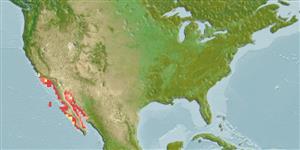>
Eupercaria/misc (Various families in series Eupercaria) >
Haemulidae (Grunts) > Haemulinae
Etymology: Anisotremus: Greek, anisos = unequal + Greek, trema, -atos = hole (Ref. 45335).
Eponymy: George Davidson (1825–1911) was a geodesist, astronomer, geographer, surveyor, engineer and revered colleague of the author who became the President of the California Academy of Sciences (1871–1887). [...] (Ref. 128868), visit book page.
More on author: Steindachner.
Environment: milieu / climate zone / depth range / distribution range
Ecologia
marino demersale; distribuzione batimetrica 0 - 40 m (Ref. 2850), usually ? - 8 m (Ref. 2850). Subtropical; 39°N - 22°N, 124°W - 106°W
Eastern Central Pacific: Santa Cruz in central California, USA to southern Baja California, Mexico; isolated population in the Gulf of California.7
Size / Peso / Age
Maturity: Lm ? range ? - ? cm
Max length : 58.0 cm TL maschio/sesso non determinato; (Ref. 2850); Età massima riportata: 15 anni (Ref. 56049)
Occur in coastal waters, frequently in rocky reefs and occasionally over sandy bottoms (Ref. 9114); often near kelp beds. Juveniles form schools in littoral pools (Ref. 9114). Feed on crustaceans, mollusks and bryozoans. Pelagic spawner (Ref. 56049). Marketed fresh (Ref. 9114).
Life cycle and mating behavior
Maturità | Riproduzione | Deposizione | Uova | Fecundity | Larve
Distinct pairing during breeding (Ref. 205). Pelagic spawner (Ref. 56049).
Eschmeyer, W.N., E.S. Herald and H. Hammann, 1983. A field guide to Pacific coast fishes of North America. Boston (MA, USA): Houghton Mifflin Company. xii+336 p. (Ref. 2850)
IUCN Red List Status (Ref. 130435: Version 2024-1)
Threat to humans
Harmless
Human uses
Pesca: scarso interesse commerciale; Pesce da pesca sportiva: si
Strumenti
Special reports
Download XML
Fonti Internet
Estimates based on models
Preferred temperature (Ref.
123201): 15.2 - 23.3, mean 21.1 °C (based on 116 cells).
Phylogenetic diversity index (Ref.
82804): PD
50 = 0.5039 [Uniqueness, from 0.5 = low to 2.0 = high].
Bayesian length-weight: a=0.01660 (0.00778 - 0.03542), b=3.02 (2.84 - 3.20), in cm total length, based on LWR estimates for this (Sub)family-body shape (Ref.
93245).
Trophic level (Ref.
69278): 3.5 ±0.46 se; based on food items.
Resilienza (Ref.
120179): Medio, tempo minimo di raddoppiamento della popolazione 1.4 - 4.4 anni (tm=2; tmax=15).
Fishing Vulnerability (Ref.
59153): Moderate vulnerability (43 of 100).
Nutrients (Ref.
124155): Calcium = 66.6 [18.1, 143.9] mg/100g; Iron = 0.994 [0.509, 2.109] mg/100g; Protein = 19 [17, 21] %; Omega3 = 0.238 [0.117, 0.441] g/100g; Selenium = 26.6 [12.7, 56.7] μg/100g; VitaminA = 6.35 [1.96, 20.67] μg/100g; Zinc = 0.595 [0.380, 0.906] mg/100g (wet weight);
